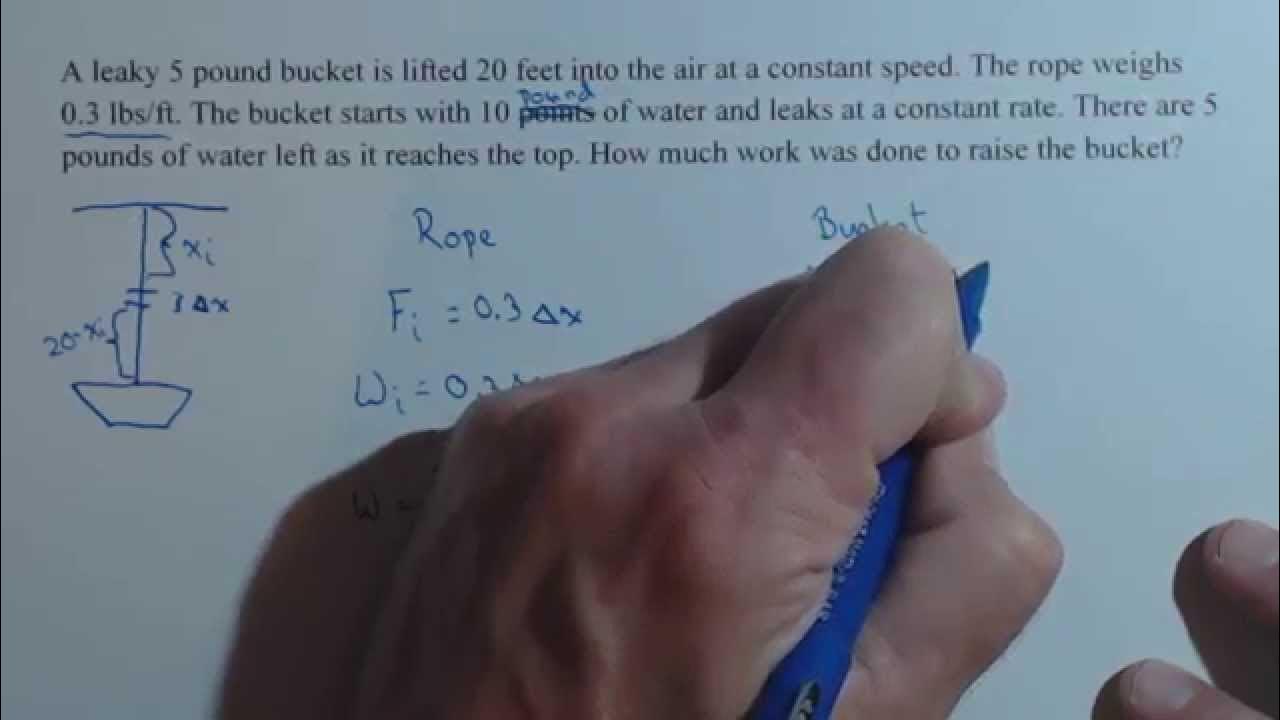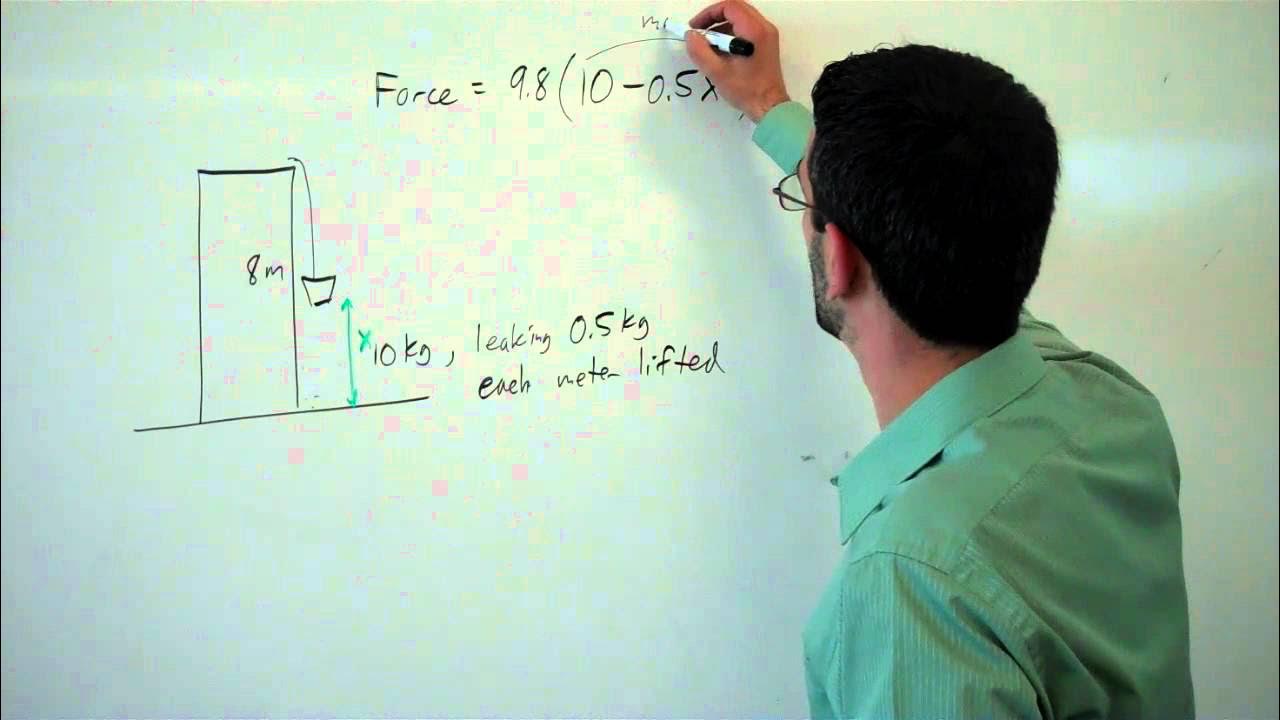Leaky Bucket
TLDRIn this educational script, the process of calculating work done while lifting a 10 kg bucket filled with 36 kg of water is explained. The bucket is lifted 12 meters high at a constant speed with a rope weighing 0.8 kg per meter. The water leaks at a constant rate, finishing as the bucket reaches the top. The work done on the bucket, rope, and water is calculated separately, considering the variable force due to the rope's weight and the leaking water. The total work done on the system is found by summing the individual work components, resulting in 3857 joules.
Takeaways
- 🔁 The problem involves lifting a bucket with a rope, calculating the work done on the bucket, the rope, and the leaking water.
- 💧 The bucket initially contains 36 kilograms of water, which leaks at a constant rate until it's empty at the top.
- 🪣 The bucket's mass is 10 kilograms, and it's lifted to a height of 12 meters at a constant speed.
- 🧵 The rope weighs 0.8 kilograms per meter, and its weight contributes to the work done as the bucket is lifted.
- 📐 The work done on the bucket is calculated using the formula for work: force times distance, resulting in 1176 joules.
- 📈 The work done on the rope requires integration due to the variable force as the bucket ascends.
- 📚 The integration of the force function for the rope yields 564.48 joules of work done.
- 🚰 The water's rate of leakage is determined by dividing the total mass of water by the height, resulting in 3 kilograms per meter.
- ⚖️ A force function for the water is created using the mass flow rate and gravity, which is then integrated from 0 to 12 meters.
- 🔢 The work done to lift the water is calculated to be 2106.8 joules, by integrating the force function over the distance.
- 📝 The total work done on the system is the sum of the work done on the bucket, rope, and water, totaling 3857.28 joules.
Q & A
What is the initial mass of the bucket in the script?
-The initial mass of the bucket is 10 kilograms.
How high is the bucket lifted in the scenario described?
-The bucket is lifted to a height of 12 meters.
What is the weight of the rope per meter?
-The rope weighs 0.8 kilograms per meter.
Initially, how much water does the bucket contain?
-Initially, the bucket contains 36 kilograms of water.
At what rate does the water leak from the bucket?
-The water leaks at a constant rate of 3 kilograms per meter as the bucket is lifted.
What is the formula used to calculate the work done on the bucket?
-The formula used to calculate the work done on the bucket is force times distance, which is mass times gravity times height (F = m * g * h).
How much work is done to lift the bucket alone, in joules?
-The work done to lift the bucket alone is 1176 joules.
How is the force function for the rope calculated?
-The force function for the rope is calculated as the product of the rope's weight per meter, gravity, and the length of the rope out (0.8 kg/m * 9.8 m/s² * (12 - x) m).
What is the work done to lift the rope, in newton meters?
-The work done to lift the rope is 564.48 newton meters.
How is the work done to lift the water calculated?
-The work done to lift the water is calculated by integrating the force function of the water's weight times the distance, with the rate of leak as the variable force (3 kg/m * 9.8 m/s² * (12 - x)).
What is the total work done to lift the entire system, in joules?
-The total work done to lift the entire system is 3857 joules.
Outlines
🔍 Calculating Work Done on a Leaky Bucket
This paragraph describes the process of calculating the work done on a 10-kilogram bucket filled with 36 kilograms of water that is lifted at a constant speed to a height of 12 meters. The bucket leaks water at a constant rate, and the water finishes leaking just as the bucket reaches the top. The work done on the bucket is calculated using the formula for work, which is force times distance. The force is the weight of the bucket, which is the mass times the acceleration due to gravity. The distance is the height the bucket is lifted. The calculation results in 1176 joules of work done on the bucket.
📐 Work Done by the Rope and Water
The second paragraph delves into the work done by the rope and the water. The rope's weight varies as its length changes during the lift, with the rope weighing 0.8 kilograms per meter. The work done by the rope is calculated by integrating the force function over the distance, resulting in 564.48 joules. For the water, the work done is calculated considering the water's weight decreasing as it leaks out uniformly over the 12 meters. The rate of leak is determined to be 3 kilograms per meter, and the work done to lift the water is found to be 2106.8 joules. The total work done to lift the entire system, including the bucket, rope, and water, is summed up to be 3857.28 joules.
Mindmap
Keywords
💡Leaky bucket
💡Work
💡Constant speed
💡Rope weight
💡Force function
💡Integration
💡Water leakage rate
💡Newton's second law
💡Joule
💡Total work
Highlights
A 10 kg bucket is lifted at a constant speed from the ground to a height of 12 meters.
The rope weighs 0.8 kg per meter and is used to lift the bucket.
Initially, the bucket contains 36 kg of water, which leaks at a constant rate.
The water in the bucket finishes leaking just as it reaches 12 meters.
Work done is calculated considering the bucket, rope, and water.
The bucket's work is calculated using the formula force times distance.
The work done by the bucket is 1176 joules.
The force function for the rope is variable due to its changing length.
The work done by the rope is calculated by integrating the force function.
The work done by the rope is 564.48 newton meters.
The water's rate of leak is calculated as 3 kg per meter of bucket's ascent.
The work done to lift the water is calculated by integrating the force function for the water.
The work done to lift the water is 2106.8 newton meters.
The total work done to lift the system is the sum of the work done on the bucket, rope, and water.
The total work done is 3857.28 newton meters, or 3857 joules.
The process involves calculating work done on each component of the system separately and then summing them.
The integration of force functions is key to solving the problem.
The problem demonstrates the concept of variable force and work done in a physical system.
Transcripts
Browse More Related Video

Work Done Raising a Leaky Bucket with an Integral

Work to lift a leaking bucket

Work done on lifting/falling things - Solved numerical | Work & Energy | Physics | Khan Academy

How to find the work done by forces on an inclined plane. Work done by friction and a pulling force.

Work Problems Examples | Calculus 2 - JK Math

Work example problems | Work and energy | Physics | Khan Academy
5.0 / 5 (0 votes)
Thanks for rating: